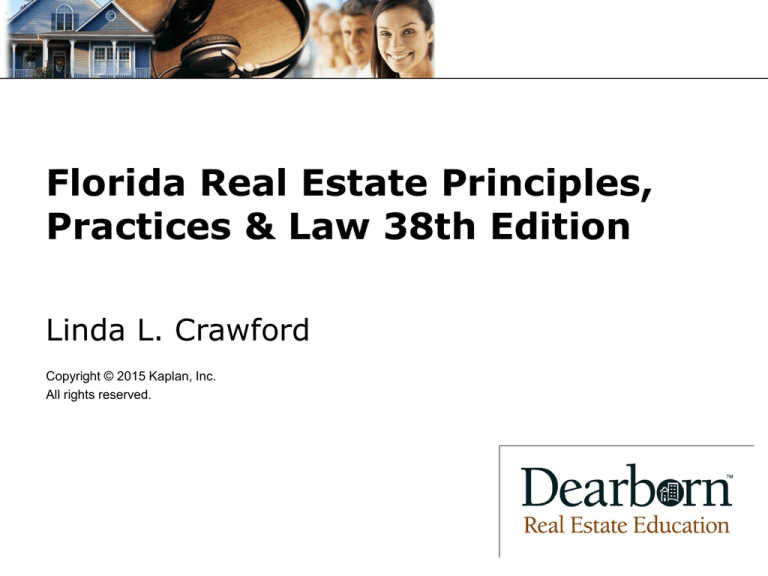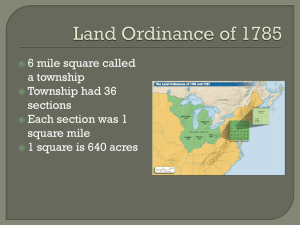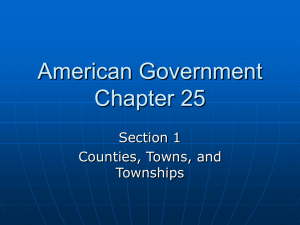
Florida Real Estate Principles,
Practices & Law 38th Edition
Linda L. Crawford
Copyright © 2015 Kaplan, Inc.
All rights reserved.
Chapter 10
Legal Descriptions
Purposes of Legal Descriptions
• Used to describe property in a way that
uniquely identifies it from any other parcel
• Survey is a drawing of a parcel showing its
boundary lines and includes the legal
description
©2015 Kaplan, Inc.
Types of Legal Descriptions
• Metes-and-bounds
• Government survey system
• Lot and block description
©2015 Kaplan, Inc.
Description by Metes-and-Bounds
– Metes refers to distance
– Bounds refers to direction
– Point of beginning (POB)
• Exact starting point
• Starting at POB, first boundary is determined from the
legal description that indicates the direction and the
distance to the first corner of parcel, and so on
• Corners of the parcel are identified with a visible
marker called a monument
©2015 Kaplan, Inc.
Metes-and-Bounds
• Begin with either north or south followed by
a number of degrees, up to 90 degrees
• Direction that follows number of degrees
indicates whether direction is east or west
of due north or south; N25°W
• Directions are given in degrees, minutes,
and seconds
©2015 Kaplan, Inc.
Metes-and-Bounds Directions
N
N45⁰E
W
E
S60⁰W
S
©2015 Kaplan, Inc.
Description by Government Survey
•
•
•
•
US System of Rectangular Surveys
Based on grid system
Used in Florida but not the original 13 states
Beginning reference is intersection of
north/south line principal meridian and
east/west line base line
• 36 Principal meridians and base lines
• Tallahassee Principal Meridian and Base Line
©2015 Kaplan, Inc.
Range
• Vertical (north/south) range lines parallel to the
principal meridian (PM)
– Every six miles
– Resulting six-mile-wide vertical (north/south) strip
called range
– Numbered beginning at PM
– First vertical strip east of PM is Range 1 East (R1E);
first strip west of PM is Range 1 West (R1W)
– Range numbers increase by moving further from PM
©2015 Kaplan, Inc.
Township (tier)
• Horizontal (east/west) township lines every six
miles parallel to the base line (BL)
– Series of lines six miles apart on either side of BL
– Six-mile-wide horizontal east-west strip called tier or
township
– Numbered beginning at BL
– First strip north of BL is Township 1 North (T1N); first
strip south of BL is Township 1 South (T1S)
– Township numbers increase moving further from BL
©2015 Kaplan, Inc.
Townships
•
Grid pattern formed by intersection of
range lines and township lines
Series of squares six miles square called
townships
• Township contains 36 square miles (6 miles on
each side)
• Identified by the township tier and range
• T2S, R3E is located in second tier of townships
south of base line and third range east of
principal meridian
•
©2015 Kaplan, Inc.
Principal Meridian, Baseline, Townships
©2015 Kaplan, Inc.
Sections
• Each township contains 36 sections
– Section is one square mile or 640 acres
– Numbered in an S-pattern beginning in NE
(upper right) corner with section 1
– Section, township and range
• Section 36, T1S, R1W
– Locating sections
– Subdividing sections
©2015 Kaplan, Inc.
Sections
©2015 Kaplan, Inc.
Measures and Terms
• Check Square 24 miles on each side created
by intersecting guide meridians and correction
lines
• Township Square 6 miles on each side
containing 36 square miles (36 sections); also
east-west strip of land north and south of a
base line
• Section Square 1 mile on each side (1 mile
square) containing 1 square mile (640 acres)
©2015 Kaplan, Inc.
Measures and Terms
Government lot
Fractional pieces of
land (less than a
full quarter section)
located along the
banks of lakes and
streams
Quarter section =
160 acres
©2015 Kaplan, Inc.
Calculating Size
To find the number
of acres in a tract
take 640 (acres in
one section) and
divide by the
denominator of
each fraction in
legal description
Example:
SW¼, NE¼, SE¼, NW¼
of Section 12, T3S, R4E
640 ÷ 4 ÷ 4 ÷ 4 ÷ 4 = 2.5
acres
©2015 Kaplan, Inc.
And in a Legal Description
If “and” is in middle
of description
calculate acres on
either side of “and”
separately then add
to find total acres
Example:
SE¼ of the NW¼ of the
NE¼ and N½ of the
NW¼ of the NE¼ of
Sec 21, T4N, R5W
640 ÷ 4 ÷ 4 ÷ 4 = 10
640 ÷ 2 ÷ 4 ÷ 4 = 20
10 + 20 = 30 acres
©2015 Kaplan, Inc.
Additional Survey Measures
• Acre – 43,560 square feet
• Benchmark – Permanent reference mark
affixed to an iron post or brass marker used
to establish elevations
• Mile – 5,280 feet in length
©2015 Kaplan, Inc.
Example of Acreage
• A lot measures 1/8 mile wide by ¼ mile
deep. How many acres are in this lot?
• Solution
5280 ÷ 8 = 660 feet
5280 ÷ 4 = 1320 feet
660 x 1320 = 871,200 sq ft
871,200 ÷ 43,560 = 20 acres are in this lot
©2015 Kaplan, Inc.
Description by Lot and Block Numbers
• Used only where plat
maps have been
recorded
– Platted subdivision
divided into large areas
called blocks
– Blocks divided into lots
– Lots are numbered
– Blocks are either
numbered or lettered
©2015 Kaplan, Inc.
Plat Map
Engineer’s plan for land use on map of land
Provides for dedication of streets, parks, and school
sites
• Shows dimensions for lots, streets, planned
improvements
• Recorded under subdivision name by book and
page number
©2015 Kaplan, Inc.
Tax Maps
• Each parcel of land within a tax district is
assessed for tax purposes
– Each parcel is assigned a Parcel ID (PID) number
by county property appraiser
– PIDs used to prepare tax maps
– Information used to prepare tax roll
– PIDs sometimes used to identify a parcel
©2015 Kaplan, Inc.








